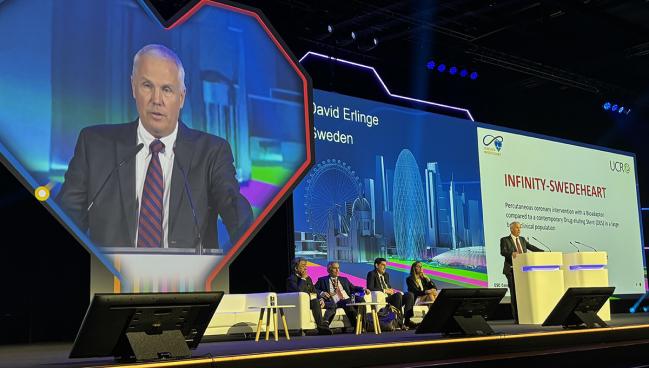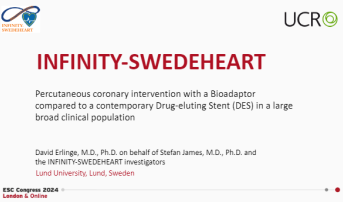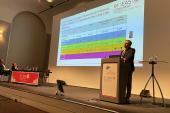‘Unlocking’ Scaffold Matches DES in Wide Range of PCI Patients, Including ACS
The DynamX Bioadaptor device was noninferior to DES for TLF overall, but a landmark analysis reveals a potential strength.

LONDON, England—A device designed to deter accruing risks of stent-related adverse events has proven itself once again in a noninferiority trial against a workhorse drug-eluting stent, results from INFINITY-SWEDEHEART show.
In a broad group of patients undergoing PCI, the primary endpoint of target lesion failure at 12 months was 2.35% in patients treated with the DynamX Bioadaptor (Elixir Medical)—a device that unlocks over time to facilitate a return to normal vessel function—compared with 2.77% in patients treated with the Resolute Onyx coronary stent (Medtronic). The difference of 0.41% in favor of DynamX fell within the noninferiority margin of 4.2% (P < 0.001).
Beyond meeting the primary endpoint, an intriguing prespecified landmark analysis showed that the risk of TLF from 6 to 12 months was significantly better with DynamX, a benefit driven by a reduction in target-vessel MI and ischemia-driven target lesion revascularization, investigators reported last week during a Hot Line session at the European Society of Cardiology Congress 2024.
“These results confirm the novel impact of the Bioadaptor in coronary artery disease treatment through its unique mechanism of action of restoring the hemodynamic modulation or the physiology of a diseased artery,” said David Erlinge, MD, PhD (Lund University, Sweden), during his presentation.
The rationale for developing the device, which falls somewhere between a conventional drug-eluting stent and a fully bioresorbable scaffold, is that there is a 2% to 3% risk of stent-related adverse events each year in patients who receive drug-eluting stents, a problem even the newest-generation DES have been unable to remedy, said Erlinge.
“A way to solve this could be to ‘leave nothing behind’ [like] bioresorbable scaffolds, but they failed at improving short- and long-term outcomes compared to drug-eluting stents, driven by poor acute performance and loss of long-term vessel dynamic support following scaffold resorption,” he said.
The DynamX Bioadaptor device received conditional CE Mark approval in 2019 in Europe and was granted breakthrough device designation from the US Food and Drug Administration in 2024 for the treatment of ischemic coronary heart disease.
Landmark Analysis From 6 Months On
With DynamX, the sirolimus-eluting scaffold is made up of three metallic helical strands joined circumferentially by a thin PLLA-bioresorbable polymer. The polymer is resorbed over 6 months, which unlocks or unchains the scaffold and disconnects the three helical strands. Unlocking the scaffold is meant to help the vessel get back to normal function while the disengaged cobalt-chromium strands provide scaffolding support.
In INFINITY-SWEDEHEART, 2,400 patients (mean age 68 years, 24% female) with chronic or acute coronary syndromes indicated for PCI at 20 sites in Sweden were randomized to treatment with the DynamX Bioadaptor or Resolute Onyx. Patients with lesions in the left main coronary artery, chronic total occlusions, bypass grafts, or in-stent restenosis were excluded. The majority of randomized patients were treated for ACS (approximately 77%), and the LAD was the most commonly treated vessel.
The rates of definite/probable stent thrombosis were low in both groups (0.68% with DynamX vs 0.51% with Resolute Onyx), while rates of target vessel failure at 12 months were 3.03% with the novel device and 3.52% with the drug-eluting stent.
Speaking during the Hot Line session, Erlinge said the prespecified landmark analysis is the most interesting aspect of the trial. From 6 to 12 months, there were just two TLF events with DynamX compared with a rate of more than 1% with Resolute Onyx (P = 0.003). Visually, the Kaplan-Meier curves with DynamX are essentially flat, while TLF events creep steadily upward with the DES. Rates of TVF were also significantly lower with the Bioadaptor in the landmark analysis.
To TCTMD, Erlinge said that prior mechanistic studies performed using quantitative coronary angiography and IVUS have shown the return of vessel pulsatility with the Bioadaptor that isn’t seen with DES. “There is positive remodeling, a larger lumen area,” he said. Dual antiplatelet therapy is standard, and the only procedural recommendation is that operators predilate the vessel prior to implanting the highly deliverable device, he said.
Davide Capodanno, MD, PhD (University of Catania, Italy), the discussant following the presentation, said current-generation DES perform very well, with low rates of TLF and stent thrombosis, which makes it challenging for new devices to better them. Even in INFINITY-SWEDEHEART, event rates were very low, which is a testament to the safety of modern PCI, he said.
The plateau in clinical outcomes at 6 months in the open-label trial is supported by prior data from the BIOADAPTOR RCT, another study showing that rates of TLF were stayed with DynamX but there was a “tax” of roughly 2% annually with Resolute Onyx. Taken together, the two studies suggest there is a real “story” when it comes to lowering the risk of stent-related adverse events with the technology, said Capodanno. If the findings from INFINITY-SWEDEHEART are confirmed over longer-term follow-up, and against other control arms, “this technology could become a serious contender to the paradigm of drug-eluting stents,” he said.
During the discussion, panelist Rasha Al-Lamee, MBBS, PhD (Imperial College London, England), wondered if any larger, superiority trials were in the works so that researchers wouldn’t have to rely on landmark analyses to prove the device’s advantage. Right now, said Erlinge, the plan is to follow these patients for 5 years and beyond, something the researchers are able to do in the SWEDEHEART registry.
Michael O’Riordan is the Managing Editor for TCTMD. He completed his undergraduate degrees at Queen’s University in Kingston, ON, and…
Read Full BioSources
Erlinge D, on behalf of the INFINITY-SWEDEHEART investigators. Percutaneous coronary intervention with a Bioadaptor compared to a drug-eluting stent in a large, broad clinical population. Presented at: ESC 2024. September 2, 2024. London, England.
Disclosures
- The trial was sponsored by Elixir Medical.
- Erlinge reports having received honoraria for advisory boards/speaker fees from Amgen, AstraZeneca, Chiesi, Sanofi, Novo Nordisk, InfraredX/Nipro, and Kaminari Medical.






Comments